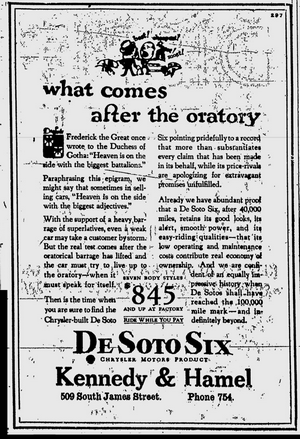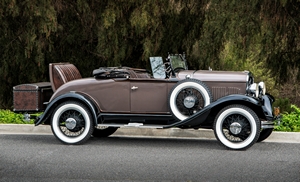















DeSoto |
|---|
|
| External Links |
|---|
| Wikipedia: DeSoto (automobile) |
| Page Sections |
|
History
Reference Desk Multimedia Article Index Photographs |
History
The following section is an excerpt from Wikipedia's DeSoto (automobile) page on 13 January 2016, text available via the Creative Commons Attribution-ShareAlike 3.0 Unported License.
The DeSoto (sometimes De Soto) is an American automobile marque that was manufactured and marketed by the DeSoto Division of the Chrysler Corporation from 1928 to the 1961 model year. The De Soto marque was officially dropped November 30, 1960, with over two million vehicles built since 1928.
1929–1942
The DeSoto make was founded by Walter Chrysler on August 4, 1928, and introduced for the 1929 model year. It was named after the Spanish explorer Hernando de Soto. The DeSoto logo featured a stylized image of the explorer who led the first European expedition deep into the territory of the modern-day United States (Florida, Georgia, and Alabama), and was the first documented European to have crossed the Mississippi River.
Chrysler wanted to enter the brand in competition with its competitors Oldsmobile, Mercury, Studebaker, Hudson, and Willys-Knight, in the mid-price class. DeSoto served as a lower priced version of Chrysler products, with Dodge and Plymouth added to the Chrysler family in 1928.
The inaugural DeSoto model year sales in 1929 totaled 81,065 cars, a first year record in the U.S. that lasted until the 1960 Ford Falcon. Shortly after DeSoto was introduced, however, Chrysler completed its purchase of the Dodge Brothers, giving the company two mid-priced makes. Initially, the two-make strategy was relatively successful, with DeSoto priced below Dodge models. Despite the economic times, DeSoto sales were relatively healthy, pacing Dodge at around 25,000 units in 1932.
However, in 1933, Chrysler reversed the market positions of the two marques in hopes of boosting Dodge sales. By elevating DeSoto, it received Chrysler's streamlined 1934 Airflow bodies. But, on the shorter DeSoto wheelbase, the design was a disaster and was unpopular with consumers. Unlike Chrysler, which still had more traditional models to fall back on, DeSoto was hobbled by the Airflow design until the 1935 Airstream arrived.
Aside from its Airflow models, DeSoto's 1942 model is probably its second most memorable model from the pre-war years, when the cars were fitted with powered pop-up headlights, a first for a North American mass-production vehicle. (The Cord 810 introduced dashboard hand cranked hidden headlamps in the 1936 model year.) DeSoto marketed the feature as "Air-Foil" lights ("Out of Sight Except at Night").
1946–1960
After wartime restrictions on automotive production were ended, DeSoto returned to civilian car production when it reissued its 1942 models as 1946 models, but without the hidden-headlight feature, and with fender lines extending into the doors, like other Chrysler products of the immediate postwar period.
Until 1952, DeSoto used the Deluxe and Custom model designations. In 1952 DeSoto added the Firedome with its 276-cid Hemi engine. However, in 1953, DeSoto dropped the Deluxe and Custom names and designated its six-cylinder cars the 'Powermaster' and its V8 car remained the 'Firedome'.
At its height, DeSoto's more popular models included the Firesweep, Firedome, and Fireflite. The DeSoto Adventurer, introduced for 1956 as a high-performance hard-top coupe (similar to Chrysler's 300), became a full-range model in 1960.
In 1955, along with all Chrysler models, De Sotos were redesigned with Virgil Exner's "Forward Look." DeSotos sold well through the 1956 model year. That year, for the first and only time in the marque's history, it served as Pace Car at the Indianapolis 500. For the 1956 update Exner gave the DeSoto soaring tailfins fitted with triple taillights, and consumers responded by buying record numbers.
The 1957 had a well integrated design, with two variations: the smaller Firesweep, the Firedome/Fireflite body placed on the concurrent Dodge 122-inch wheelbase chassis with Dodge front fenders; and the Firedome and Fireflite (and its halo model Adventurer sub-series), based on the larger 126-inch wheelbase chassis shared with Chrysler. As was conventional in the era, subsequent years within the typical three-year model block were distinguished by trim, bumper, and other low-cost modifications, typically by adding bulk to bumpers and grilles, taillight changes, color choices, instrumentation and interior design changes and often additional external trim.
The 1958 economic downturn hurt sales of mid-priced makes across the board, and DeSoto sales were 60 percent lower than those of 1957 in what would be DeSoto's worst year since 1938. Also Ford Motor Company had introduced a new mid-price competitor for the 1958 model year with the Edsel. The sales slide continued for 1959 and 1960 (down 40 percent from the already low 1959 figures), and rumors began to circulate DeSoto was going to be discontinued.
1961
By the time the 1961 DeSoto was introduced in the fall of 1960, rumors were widespread that Chrysler was moving towards terminating the brand, fueled by a reduction in model offerings for the 1960 model year. The introduction of the lower priced Newport to the upscale Chrysler brand no doubt hastened the decision to end production of DeSoto, which was very similar in size, styling, price, and standard features.
For 1961, DeSoto lost its series designations entirely, in a move reminiscent of Packard's final lineup. And, like the final Packards, the final DeSoto was of questionable design merit. Again, based on the shorter Chrysler Windsor wheelbase, the DeSoto featured a two-tiered grille (each tier with a different texture) and revised taillights. Only a two-door hardtop and a four-door hardtop were offered. The cars were trimmed similarly to the 1960 Fireflite.
The final decision to discontinue DeSoto was announced on November 30, 1960, just forty-seven days after the 1961 models were introduced. At the time, Chrysler warehouses contained several million dollars in 1961 DeSoto parts, so the company ramped up production in order to use up the stock. Chrysler and Plymouth dealers, which had been forced to take possession of DeSotos under the terms of their franchise agreements, received no compensation from Chrysler for their unsold DeSotos at the time of the formal announcement. Making matters worse, Chrysler kept shipping the cars through December, many of which were sold at a loss by dealers eager to be rid of them. After the parts stock was exhausted, a few outstanding customer orders were filled with Chrysler Windsors.
Reference Desk
The Crittenden Automotive Library's "Reference Desk" is a collection of materials that cannot be shared due to copyright restrictions. Information from these resources, however, can be shared. Go to the Reference Desk page for more information.
| Type | Title |
|---|---|
2006  Book Book | Standard Catalog of 1950's Chrysler by Jon G. Robinson; Krause Publications |
| Subject: DeSoto Commercial
Source: Prelinger Archives Download [DeSoto Commercial] from The Internet Archive - 2.3MB - 0:10 |
| Date | Article | Author/Source |
|---|---|---|
| 26 May 1929 | CHANGES IN STYLE RAPID IN MOTOR CAR INDUSTRY "Style improvement has been more pronounced and rapid in the automobile industry than in any other business," said George Kennedy of Hamel & Kennedy, local dealers for the De Soto Six. | News Article (text) Publication: The Ludington Daily News Topic: DeSoto |
| 24 September 1955 | Lodi Dealers See Preview Of New DeSoto Line DeSoto dealers of the San Francisco region, including Boyd Mitchell and John Koenig, of Lodi, yesterday previewed the new 1956 DeSoto line. | News Article (text) Publication: Lodi News-Sentinel Topic: DeSoto |
| 7 April 2013 | Dream Cars: Reviving...DeSoto? Sure, automakers photograph Hispanic people in their cars and publish the ads in Spanish-language magazines, but they're still selling the same cars that were designed by and for a different culture. | News Article (text) Author: Bill Crittenden Topic: DeSoto |
 |
Subject: Kennedy & Hamel 1929 DeSoto Ad
Source: The Ludington Daily News Date: 24 May 1929 View photo of Kennedy & Hamel 1929 DeSoto Ad - 1.5MB |
 |
Subject: Antique DeSoto
Photographer: Mark Dengan Location/Event: Laguna Nigel, California, USA 
Date: 1 April 2018 License: Pexels View photo of antique DeSoto - 6.3MB |
 |
Subject: 1929 DeSoto
Source: Antique Automobile: March-April 1972 View 1929 DeSoto Advertisement - 732KB |
 |
Subject: 1953 DeSoto Ad
Source: The Saturday Evening Post Date: 21 March 1953 View photo of 1953 DeSoto Ad - 21.7MB |
